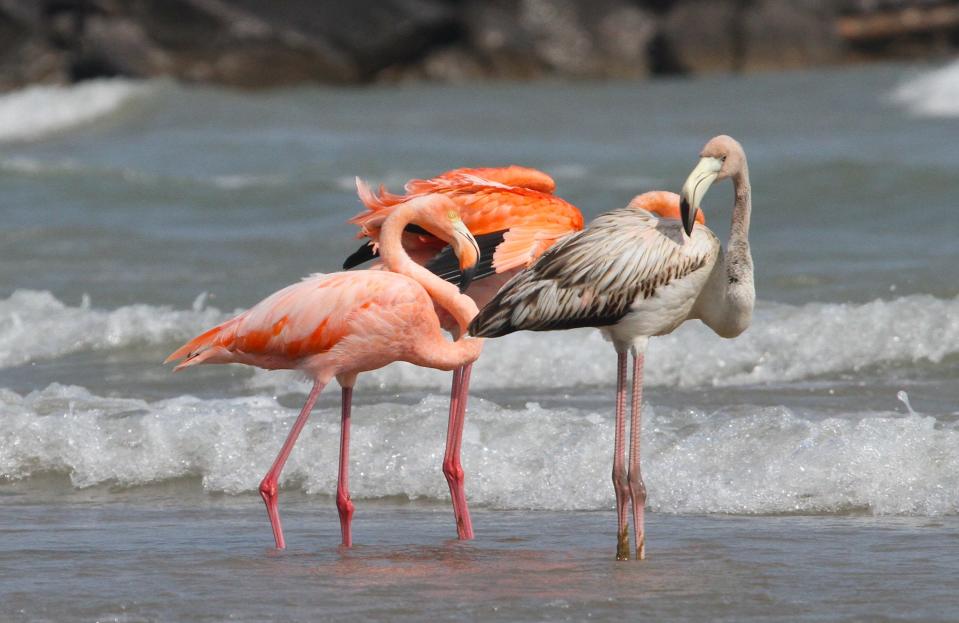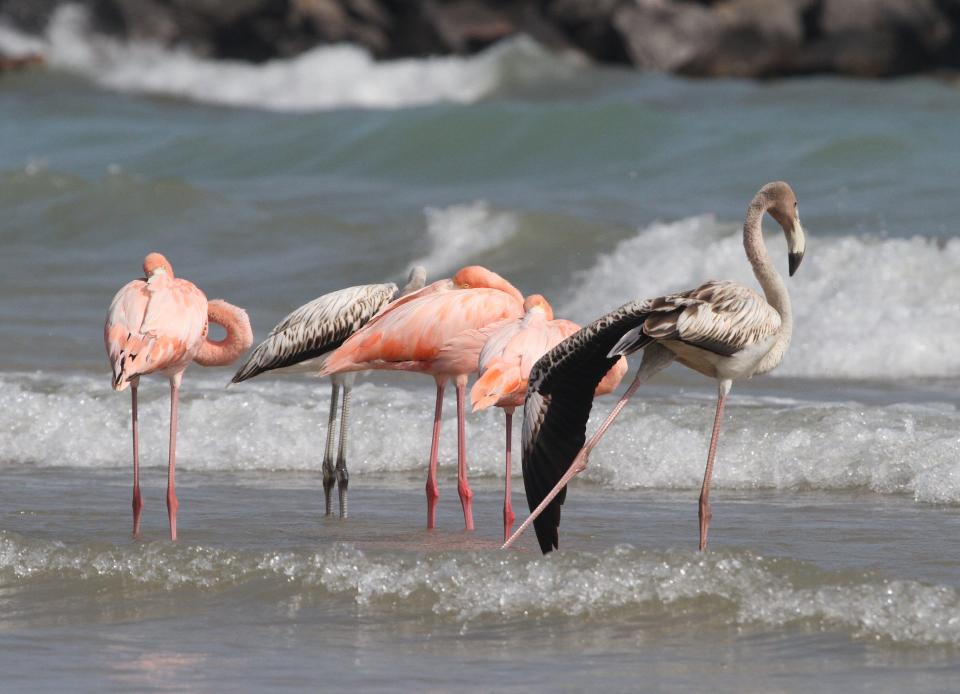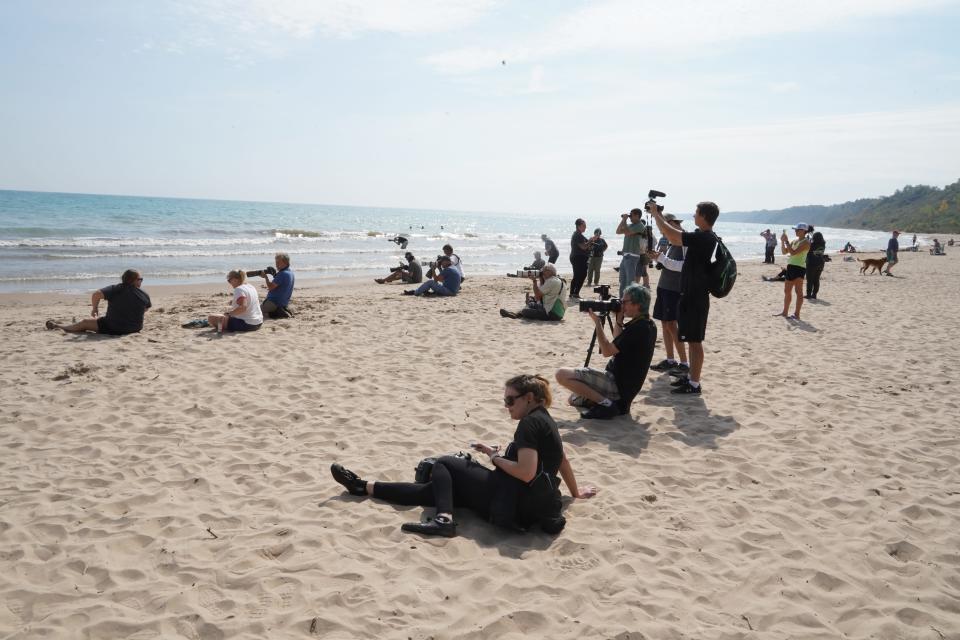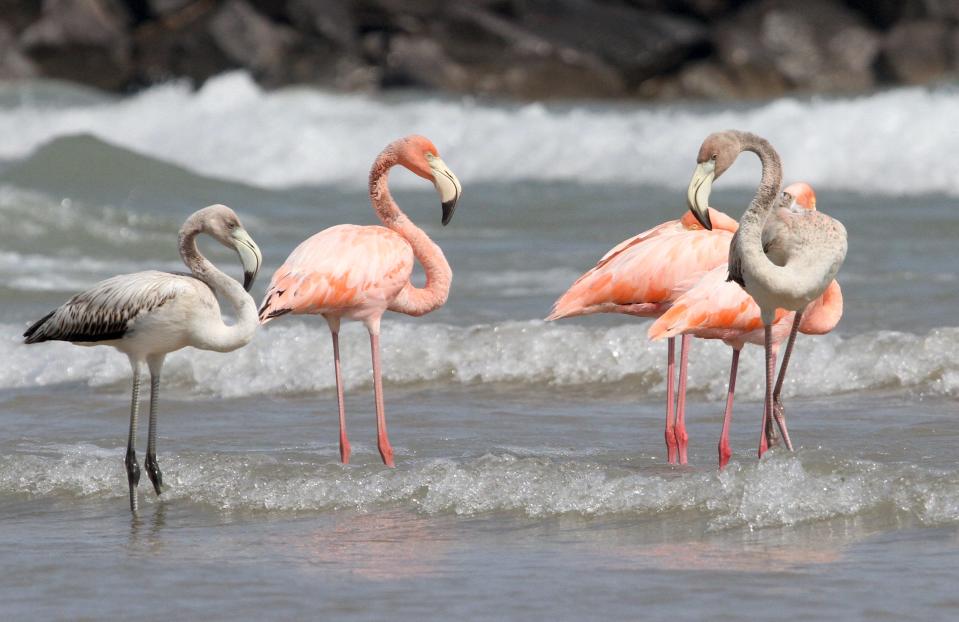'Make a sandwich, we're going:' Flamingos draw a crowd to Port Washington
PORT WASHINGTON - Plastic replicas on Bascom Hill in Madison, yes.
Real, wild flamingos anywhere in Wisconsin, never.
At least not until Friday.
Bird watchers, wildlife photographers and a few beachgoers were treated to the view of five American flamingos Friday at South Beach in Port Washington.
The sighting was the first in state history, according to Mark Korducki, a member of the Wisconsin Society for Ornithology. The organization is the official keeper of state bird records.
After word spread on social media, a crowd of 75 people assembled at noon Friday to take in the unprecedented view.
The birds stood quietly just 25 feet off the Lake Michigan shore. Three were adults, identifiable by their pink plumage, and two were juveniles still clad in gray.
As waves lapped against their thin legs, the flamingos mostly dozed in the late September sunshine.

"This is huge," said Jim Edelhuber of Waukesha, an avid bird watcher and photographer. "This is unbelievable."
Like most, Edelhuber heard about the sighting through social media channels late Friday morning.
"My wife says, 'make a sandwich, we're going,'" Edelhuber said.
The flamingo sighting filled another spot on the Wisconsin life lists of every birder present. For Edelhuber, it made 375 species seen in the state.
The sighting was unexpected but not a total shock because of recent reports of flamingos in Indiana, Kentucky, Ohio and Pennsylvania, said Ryan Brady, conservation biologist with the Wisconsin Department of Natural Resources.
The typical range of the American flamingo is Florida and other Gulf Coast states as well as the Caribbean and northern South America.
How did they end up in the Badger State?
The hypothesis put forth by wildlife biologists is the flamingos were pushed north in late August by the strong winds of Hurricane Idalia.

Wisconsin has had several "celebrity" bird species visit the state this year, including limpkin, roseate spoonbill and, in a state first, flame-colored tanager.
The flamingo is now the second "first" record of the year.
The Wisconsin sighting immediately triggered "flamingo mania." The parking lot at South Beach overflowed with cars at noon and people began to park several blocks away and hoof it to the beach.
Two Facebook sites, Port Washington Voice and Wisconsin Rare Bird Alert, posted info on the flamingos in late morning.
"I've only ever seen (flamingos) on our trips to Aruba," said Debbie Gasper of Port Washington, who made the short trip to the lakefront with her husband Mark. "I'm going to have to send photos of this or our relatives in Georgia aren't going to believe it."
The crowd at South Beach included dozens of wildlife photographers equipped with telephoto lenses who made the impromptu dash to see the birds.
But Jim Sellon of Mequon had plans to be at the beach well before any rare bird report. Sellon, bare-chested and attired in swimming trunks, sat on a folding chair and smiled at the scene.
"I come here often just like this to sit in the sun and read a book," Sellon said. "It's a beautiful, sandy beach but I have to say I've never seen so many people here in September."
Although one photographer risked disturbing the birds when he waded into water to try to get a better vantage, the crowd mostly stood and watched from a respectful distance on the beach.

The flamingos were likely exhausted from flight. As they stood resting in the shallow water they often tucked their head under a wing.
"There's a good chance they flew in this morning," Brady said. "And who knows from where. It's pretty hard for five flamingos to go unnoticed."
The American flamingo stands up to 5 feet tall thanks to long legs and an elongated neck, according to the Florida Fish and Wildlife Conservation Commission. Its average weight is 4 to 8 pounds.
The birds get their pink to red plumage from pigment in their food, including aquatic invertebrates such as shrimp.
Brady said since the sighting was not a "one off" and it fits a pattern seen recently in other states, he was convinced the flamingos were wild.
And although some people expressed concern about the birds' welfare, he said at this point the flamingos showed so signs of injury, illness or distress so rescue efforts were not warranted.
"I would think they are just resting for now," Brady said. "When it's time to feed they will probably have to move to an environment that's richer, maybe a marsh or inland lake."

Brady said flamingos have a fairly diverse diet, including algae and plant matter as well as crustaceans, zooplankton and small fish.
Flamingos are not migratory species but they do possess the ability to fly long distances and know their location. How long they'll stay in Port Washington or where they'll go next is unknown.
"But if five flamingos show up, someone will report them," Brady said. "It's also possible they might also just turn around and head south tomorrow."
For now Wisconsin is on record as the 12th and northern-most state to have a confirmed flamingo sighting.
Similar to the roseate spoonbill that frequented wetlands near Green Bay earlier this year, the flamingo sighting helps broaden interest in wildlife, Brady said.
"This bird is so big and recognizable you could take 100 people at random and they would all probably correctly identify these as flamingos," Brady said. "It's a wildlife phenomenon. If they stick around they will be very, very popular."
This article originally appeared on Milwaukee Journal Sentinel: 'Flamingo mania' draws crowd to Port Washington beach in Wisconsin

